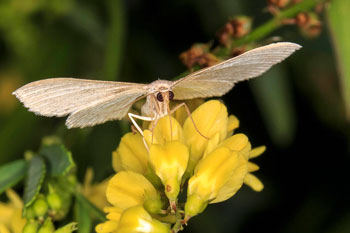
By Dan Zarlenga, Missouri Department of Conservation
Photo Caption: A moth hard at work pollinating the night away. Photo by Dan Zarlenga
Just because people go to sleep at night, doesn’t mean nature does. One of nature’s busiest nocturnal creatures of summer are the moths. You’d be forgiven if you were to mistake a moth for a butterfly since the two groups of insects are both members of the order Lepidoptera, and closely related. You might say they are even cousins! While related, moths and butterflies nevertheless have distinct differences.
For one thing, moths have thick, stout bodies filled with hairs, while butterflies are thin and have “clean shaven”, smooth bodies. The antennae of moths tend to be either simple, or fringed or feathered. Compare that to butterflies, who sport long, “clubbed” antennae, meaning they have an enlarged segment at the outer end. While butterflies are a flutter during the day, moths are more creatures of moonlight, being active either at night, dawn, or dusk. Butterflies often display splendid and striking colorings, while most moths (but not all) are dull or drab in color.
Now, while moths may not be able to compete with their daytime cousins for beauty, they more than make up for it in the work they do for pollination. Like butterflies, moths are key pollinators, and they ensure this vital activity carries on both day and night. In fact, they are so helpful in this regard, some flowers have even made special adaptations to accommodate moths. Missouri evening primrose, often found on dolomite glades or dry, rocky prairies, relies on moths for its propagation. It produces showy, yellow blossoms which are easier to see at night, and the flowers give off a strong scent during the evening that attracts moths.
Moths also blow away butterflies in number! There are about 160,000 varieties of moths in the world, most of which are nocturnal. 12,000 moth species occur in North America. With so many moths, their diversity of shapes, sizes, colors, and habits is nothing short of mindboggling. There are way too many to even begin describing here!
Mighty though they may be, moths do have a weakness—artificial lights. Streetlights, porchlights, and other sources of artificial illumination disrupt the darkness moths are used to. The unnatural light confuses them and locks them into a never-ending orbit as they fly around the source. Moths circling around these lights are distracted from their vital job of pollination.
There are some things we can do to help minimize the effects of light pollution on moths and other nighttime creatures:
- Don’t leave porch and yard lights on all night; use lighting only when needed
- Light just the areas with a real need for light; avoid decorative or landscape lighting
- Choose lights that are no brighter than required, and try to avoid those with blue emissions
- Where lights are used, use fully-shielded fixtures that direct all the light downward where it is truly useful. Scattered light in other directions wastes energy and creates glare, making it harder to see.
- Employ motion-detection lights over constant ones where security is a concern
Many of us do our best to help bee and butterfly pollinators, so why not also extend a helpful hand for our nocturnal pollination heroes, the moths? They may not be as pretty, but they are certainly pretty important!


